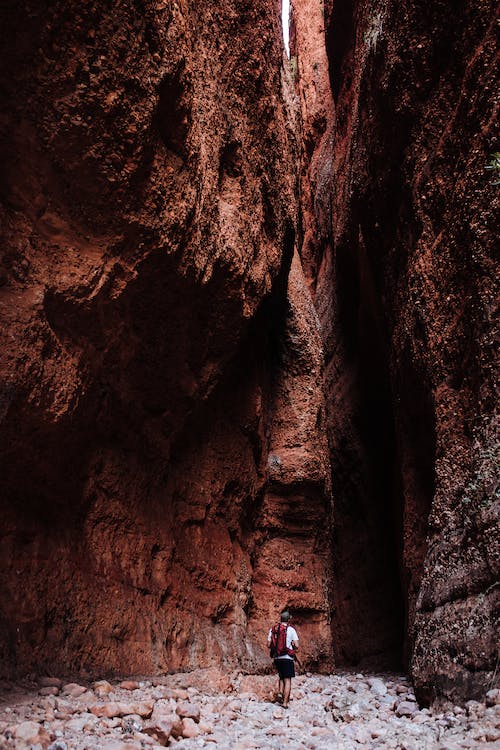Boxwork is the geological term for an uncommon network of mineral structures, usually protruding in bedrocks, cave ceilings, and highly erosive areas. They commonly consist of thin blades of dissolved calcium carbonate crystallized in the cracks of surrounding rock. Most cracks intersect at angles forming a honeycomb pattern. At a phreatic phase, or when a cave is filled with water, the surrounding rocks will be eroded, leaving the more resistant calcite crystals projecting at the surfaces. The world’s most extensive display of boxwork deposits is located at Wind Cave National Park in South Dakota, USA.
ABOUT THE PARK
After years of exploration and site mapping, Wind Cave made it to the world’s largest known caves. Geologists have measured over 150 miles of passages, making it the third-longest cave in America and the sixth-longest cave across the globe. About four miles of the cave are being discovered every year. The cave boasts its massive collection of boxwork in addition to its stalactites and stalagmites. The national park is home to native wildlife, including bison, coyotes, elk, mule deer, and pronghorn, all supported by the 28,295 acres of mixed-grass prairie. It is situated 10 miles north of Western South Dakota Hot Springs. The Wind Cave was named after its strong winds (up to 75 miles per hour) at the entrance. Wind Cave was also the first cave to be declared as a national park.
WIND CAVE NATIONAL PARK HISTORY
The Lakota, a group of indigenous people at the state’s Black Hills region, first spoke of a hole that blew air. They considered the place sacred, believing to be where they came from during the world’s creation. Tom and Jesse Bingham made the cave’s first recorded discovery in 1881. According to the stories, they heard gushing winds out of a hole in the ground, and when Tom peeked at it, the exiting cave air blew his hat away. The cave is said to be “breathing” as air moves in and out of the passages. This air movement happens because atmospheric pressure inside and outside of the cave consistently reach for equilibrium. When outside atmospheric pressure is higher, the air flows into the cave to balance it out. When the pressure inside the cave is otherwise higher, air leaks out of it as well. Strong winds moving towards the outside is usually an indicator of an approaching storm. Atmospheric pressure is dropping fast, causing the cave’s high-pressure air to flow out at all the openings. Former Theodore Roosevelt designated the place as the seventh U.S. national park in 1903.
VISITING THE PARK
- Weather – remember to bring sweaters even in the summer season as the temperature inside the cave drops at 12℃. When you visit Wind Cave from November to March, the open park above the cave reaches freezing temperatures. For hiking, wildlife watching, and other outdoor activities, the best time to book a tour are between April to October. If you are interested in catching the park’s flower’s full bloom, visit the place during the late spring to mid-summer.
- Cave Tours – there are different tour packages to choose from: the Garden of Eden, Natural Entrance, Fairgrounds, Candlelight, and Wild Cave.
- Garden of Eden Cave Tour – this is an easy 60-minute in half a mile tour designed for people with limited or with disabilities.
- Natural Entrance Tour – this tour takes 75 minutes in a two-thirds mile tour with approximately 300 stairs downhill. Participants enter through and man-made entrance and exit through an elevator.
- Fairgrounds Cave Tour – this 90-minute tour explores both the upper and middle portions of the cave. Boxwork displays are abundant at the middle level, while trail winds and frostwork are abundant on the upper level. This tour is only available during summer.
- Candlelight – this unique tour allows you to explore the wind cave using candlelight. For two hours, the tour guide will take you to an unlit section of the cave and undeveloped trail surfaces. Reservations are required as they can only cater to ten people in a group.
- Wild Cave Tour – This is a four-hour tour where visitors will be introduced to basic caving. Participants will need to fit through a space that is 1 foot tall and 3 feet wide. The tour fee costs $30.00, and the park will provide helmets, lights, and kneepads. Reservations are required.
- Ranking Ridge Nature Trail – This trail allows you to get views from the park’s highest point. The path is 1.6 kilometers in the distance, and the hiking time is 45 minutes. To reach the trailhead, follow the route number 8 and look for signages that point to the Ranking Ridge Nature Trail.
- Elk Mountain Nature Trail – Visit the place where Wind Cave’s grassland meets with the forest. The trailhead is located at Elk Mountain Campgrounds. The estimated distance is 1.6 kilometers in a one-hour hiking time. You can bring pets, provided that they were leashed, in this trail.

